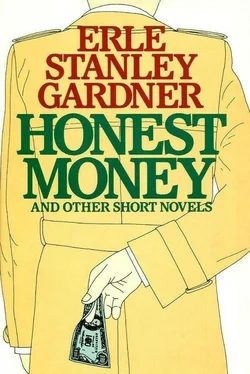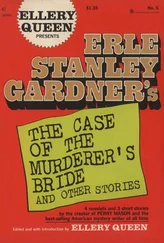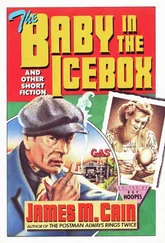The voice at the other end of the line chuckled.
“Sorry, old man,” it said, “but there’s been a note come through, that the case is to be dismissed and the complaint withdrawn.”
“I see,” said Ken Corning, and hung up the receiver.
Joe Vare, private detective, sat in Ken Corning’s office, and looked across at the lawyer.
“I don’t get you,” he said.
“It’s simple,” Corning told him, “Go to the Cadillac agency, get the list of new car deliveries, check the people carefully, find out if one of them might be the sort to have had some connection either with Sam Driver or with Harry Green.”
Vare twisted a half-smoked cigar thoughtfully, rolling it with his thumb and forefinger.
“Driver and Green were bums?” he said.
“You might call them that.”
“Think they’d have friends who drove new Cadillacs?”
Corning leaned forward.
“Get this, Vare,” he said. “This is a murder case, and the Cadillac car is a lead. In a murder case I run down all leads, no matter how shaky they look.” Vare got to his feet and grinned at the attorney.
“Okey,” he said. “I’m on my way.”
As the detective left the office, Helen Vail slipped through the door, closed it behind her, and said softly: “There’s a Mrs. Brown out there, who wants to see you about the Driver case.”
“All right,” said Corning, “let’s take a look at her.”
Helen Vail held the door open and nodded. A woman of approximately thirty or thirty-one years of age, modishly attired, came into the office, and regarded the attorney from wide, brown eyes. She wore a brown, tight-fitting hat, brown dress, brown shoes and stockings. Her clothes gave the appearance of well-tailored wealth.
“Sit down,” said Corning, as Helen Vail gently closed the door.
The woman dropped into a chair.
“What can I do for you, Mrs. Brown?”
“Nothing,” she said. “I think I can do something for you.”
He raised his eyebrows.
She opened her purse and took out a roll of currency, which she held in her gloved fingers.
“I’m going to be frank with you,” she said.
“Yes,” said Corning, “go ahead.”
“You’re representing a man by the name of Sam Driver, who is accused of murder?”
“Yes.”
“I don’t want Mr. Driver to know that I came to you.”
“Does he know you, Mrs. Brown?”
“Yes,” she said. “You see, I used to know Sam Driver in the old days — that was a long time ago. Our roads separated. We went different ways. He went his way and I went mine. He went down and I went up.”
“All right,” he said. “Go on.”
“The District Attorney hasn’t got much of a case against Driver. It’s largely circumstantial evidence. You’ve beaten the prosecution once or twice in some spectacular cases. They’re afraid of you. If you’ll have Driver think up some good story about a fight and a killing in self-defense, the District Attorney will let Driver plead guilty to manslaughter. But if the man stands trial, he’s going to be railroaded.”
“What makes you think that?”
“I don’t know. I know there are powerful influences at work against him, that’s all.”
“Where do you get your information?” asked Corning, watching her closely.
“About what?”
“About the District Attorney’s office, for instance, and the powerful influences.”
She shook her head, and the brown eyes softened into a twinkle as she regarded him.
“You have your professional secrets,” she said. “I have mine. I’m just telling you.”
“Well, then,” he said, “tell me some more.”
She looked down at the tips of her gloved fingers, suddenly raised her eyes, and, with an expression of utter candor on her face, said: “If he doesn’t plead guilty, they’re going to give him the death penalty.”
“Why?” he asked.
“For lots of reasons. There’s politics mixed up in it, and you know what politics are in York City.”
“Yes,” he told her, “I know. But why should politics be mixed up in the killing of a hobo?”
“That’s something else again,” she replied. “You’re frightfully inquisitive for a lawyer.”
“Well, what am I supposed to do?”
“Take this money. Use it as an additional fee. I don’t suppose you got much from Sam Driver. Go ahead and work out a good story with him. It’s got to be a good story with a self-defense angle to it — something that the District Attorney’s office can give to the newspapers to keep the people from making a very strong protest when they accept a plea of manslaughter.”
“Who handles the publicity?” asked Corning, still watching her narrowly.
“You fix up the story,” she said. “Your client will spill it to a newspaper reporter or the District Attorney.”
“Suppose he makes a statement that constitutes an admission to the killing, and then you’re wrong about what the District Attorney is going to do?” Corning asked.
“I’m not wrong,”
“That’s what you say. I can’t risk my client’s life on the strength of your unsupported word.”
She bit her lip for a moment.
“I hadn’t thought of that,” she said, slowly.
She looked down at the tip of her brown shoe for a few moments, then straightened and pushed the money across the desk towards Ken Corning.
“I think I can figure out a way so it will be all right,” she said.
Ken Corning regarded the roll of bills.
“I can’t take money from you,” he said, “to do what you think is best for my client. I’ve got to do what I think is best.”
“I understand that. But I know you wouldn’t take the money from me, unless you were going to play fair.”
Ken Corning reached out and took the money.
“Just a moment,” he said, moving towards the outer office, “and I’ll get you a receipt.”
Ken Corning pushed his way through the door, closed it behind him, and nodded to his secretary;
“Helen,” he said, in low, swift tones, “put on your hat, go down on the elevator and stand in the lobby of the building. When this woman comes out, tail her. See where she goes. Let me know as soon as you find out.”
She slid back her chair from the desk, and was reaching for her hat as Corning turned back towards the private office. He had a blank receipt form in his hand.
“You’ll have to give me your full name, in order to get a receipt,” he said to the woman who called herself Mrs. Brown.
“I don’t want a receipt,” she said.
Ken Corning shrugged his shoulders.
The woman got to her feet, smoothed down her skirt, and smiled at him,
“I think we understand each other,” she said.
“I’m not certain that I understand you,” he told her.
“Oh, well,” she said brightly, “I think I understand you — perfectly.”
She was very trim and straight as she marched from the office, closing the door gently after her.
Several minutes passed, and Corning heard the door of the outer office open and close. He remembered that Helen Vail was out, and got to his feet, walked across his private office, and opened the door.
A tall, well-groomed man, with cold eyes and a smiling mouth, said: “You’re Ken Corning?”
Corning nodded.
“I’m Jerry Bigelow,” said the man, and shook hands.
As he saw there was no look of recognition on Corning’s face, he added: “The man who runs the column entitled ‘Inside Stuff’ in The Courier.”
Corning ushered him into the inner office, and the man sat down in a huge leather chair, crossed his knees, and tapped a cigarette on a polished thumbnail.
“I’ve got orders to mention your name in my column,” he said.
Читать дальше












